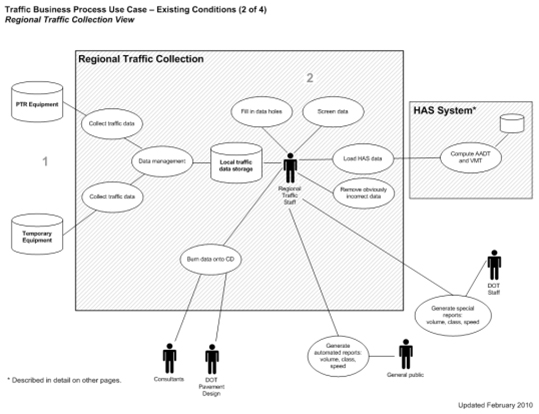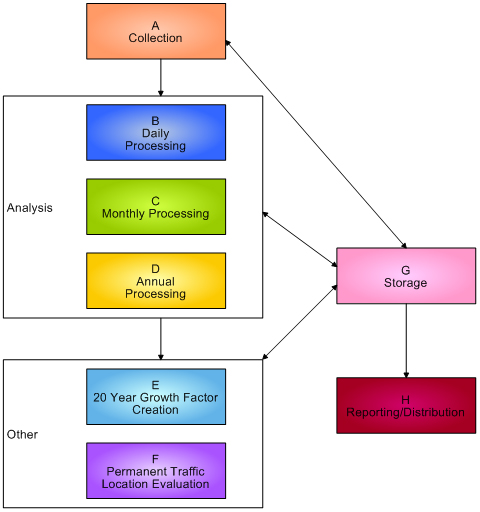U.S. Department of Transportation
Federal Highway Administration
1200 New Jersey Avenue, SE
Washington, DC 20590
202-366-4000
The example below summarizes the ADOT&PF process for traffic data collection in the regions. This information is excerpted from the Traffic Data Systems Concept of Operations report for ADOT&PF (June, 2011).
The traffic data collection process is the responsibility of the regions, with the Headquarters Program Development Division being responsible for maintaining the database of the traffic data for analysis and reporting in the Highway Analysis System (HAS).
There are two types of volume counts that are taken in the regions: the continuous counts and the coverage counts. These are identified as “collect traffic data” in Figure L-1.

Source: Alaska Department of Transportation
In 2006, the Georgia Department of Transportation (GDOT) conducted a Traffic Count Strategy Plan to maximize the value and return-on investment of scarce transportation revenues, and to ensure that customers’ needs for traffic data were being met. The following elements were included:
- Overview of Existing Traffic Data Systems;
- Equipment Set Up and Maintenance;
- Quality Assurance;
- Description of Existing Georgia DOT Office of Transportation Data Reporting and Data Sharing Process;
- Description of Additional Programs; and
- Summary of Business Processes.
- Federal Requirements Related to Traffic Data Collection; and
- Summary of Other Key Federal Literature Related to Traffic Data Collection.
- Traffic Monitoring Guide (TMG);
- Highway Performance Monitoring System (HPMS) Field Manual; and
- AASHTO’s Guidelines for Traffic Data Programs.
- Short-Term Actions for OTD;
- Mid-Term Strategies; and
- Long-Term Strategies.
- Documentation;
- Retrieval of Data/Reports;
- System Design;
- Specials Program Improvement; and
- Balancing Resources.
- Documentation;
- Retrieval of Data/Reports;
- System Design;
- Specials Program Improvement; and
- Balancing Resources.
This project enabled GDOT to move forward with the recommended improvements including procuring a traffic data software solution.
The Colorado Department of Transportation (CDOT), Division of Transportation Development (DTD) and Traffic Analysis Unit (TAU), has been very proactive in improving the CDOT traffic data program. In 2008, CDOT embarked on a business planning process review project. Phase 1 of the Traffic Analysis Business Process and Integrated Software Recommendations project resulted in the development of a comprehensive set of business process diagrams and maps documenting the existing and recommended business process overview. The report included specific evaluations of the capability of their traffic software project to streamline and improve CDOT’s collection and analysis processes. The recommended processes resulted in an estimated reduction of 318 different business processes. Recommendations of the Phase 1 report also included specific areas of improvement for CDOT associated with resources, processes, and tools. Phase 2 included follow-up on the recommendations from Phase 1; update of business process diagrams and creation of new process diagrams; improvement of the process of local traffic data sharing; development of a digital portal and requirements report; and recommendations for further enhancement of the CDOT traffic data program.
The following figure documents the high-level processes. There are numerous other detailed diagrams and process steps.

Source: Colorado Department of Transportation.